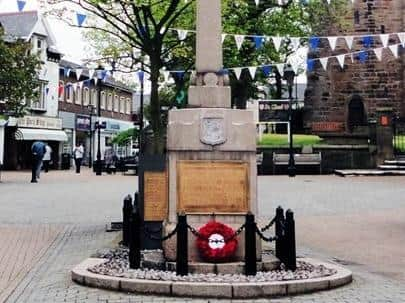Two Wyre war memorials given listed status by Historic England
and live on Freeview channel 276
The Department for Digital, Culture, Media and Sport added 132 memorials to the National Heritage List on the advice of Historic England.
Both Poulton's and St Michael's war memorials were among those added, and have been given Grade II listed status.
Advertisement
Hide AdAdvertisement
Hide AdFirst unveiled in 1921, Poulton war memorial was erected to commemorate 43 members of the local community who lost their lives in the First World War.


The last name on the roll of honour has been blanked out, suggesting that a formerly missing soldier was found after the plaque was first prepared.
After the Second World War a similar plaque was made, listing 41 names.
Another name has been added at the end of this list, and an additional plaque lists a further three names.
Advertisement
Hide AdAdvertisement
Hide AdThey are now fixed to a modern slate plinth, and face the memorial. On the back of the plinth an additional plaque commemorates Poulton's Fusilier Sam Flint-Broughton, who died fighting in Afghanistan in 2013 aged 21.
The war memorial in the memorial garden of St Michael's Church was first marked on the 1932 Ordnance Survey map.
The men’s regiments, and the names of those who served and returned, are found on a roll of honour in the church.
After the end of the Second World War a tablet was installed at the foot of the memorial commemorating the names of three servicemen who died in the conflict, as well as one man who died in Palestine in 1947.
Advertisement
Hide AdAdvertisement
Hide AdDuncan Wilson, chief executive of Historic England, said: “Our war memorials across the country remind us of the huge sacrifices made by generations in the conflicts of the last century, and provide communities with a focal point to express their gratitude and loss.
“We are proud to continue our work in recognising and protecting these important public monuments so future generations can continue to honour and remember the fallen.”
Nigel Huddleston, heritage minister, said: “I am very pleased that this year, as we mark the centenary of the Cenotaph itself, we have protected 132 memorials so that future generations can learn about those who gave so much to our country.”
Due to coronavirus restrictions, the public were asked to mark Armistice Day at home today, and not to visit the sites.
What does Grade II listed mean?
Advertisement
Hide AdAdvertisement
Hide AdListed buildings are considered nationally important and have extra legal protection within the planning system.
When a building is of special architectural or historic interest considered to be of national importance, it is given listed status.
There are different listing specifications, grade I, grade II* and grade II. Grade I buildings are deemed to have the highest significance.
All listed buildings are added to the National Heritage List for England.